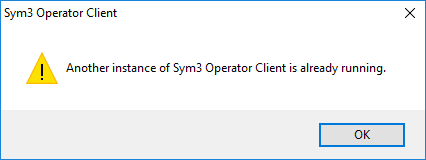Introduction
The PC Client (Sym3 Operator Client) is a desktop application running on Windows. This application will (in a standard scenario):
- Connect to Sym3 Web Server to download the active project (
.s3o). - Load the project.
- Display the layout how it has been defined in the project file.
- Connect to Sym3 Operator Server to receive live SCADA updates.
- Connect to Sym3 Alarm Server to receive and display alarms.
💡 Sym3 is delivered with a web client, please refer to this guide to know more about it.
⚠️ The PC Client is using 3D graphics and requires a graphics card supporting OpenGL, meaning that if you run the PC Client on a virtual machine (by default they do not support OpenGL), the 3D graphics will be disabled.
When the PC client starts, by default it will display the following menu. The user can choose to start a configuration from the ones previously defined or configure the selected configuration for a Sym3 Client.
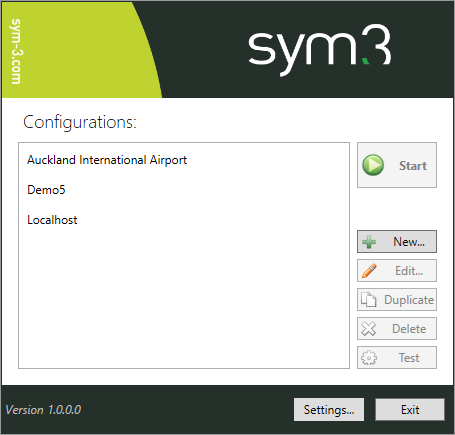
It is better to avoid multiple instance of Operator Client on the same PC so a warning has been added when starting another instance. Sym3 will also detect if a client is running on another user connected on the computer.
Configurations
A list of the currently defined Client configurations to choose from.
New…
Creates a new configuration with the default name of ‘Configuration1’ where the number increments for each new configuration.
There is no limit to the number of configurations that can be set up in the Client manager.
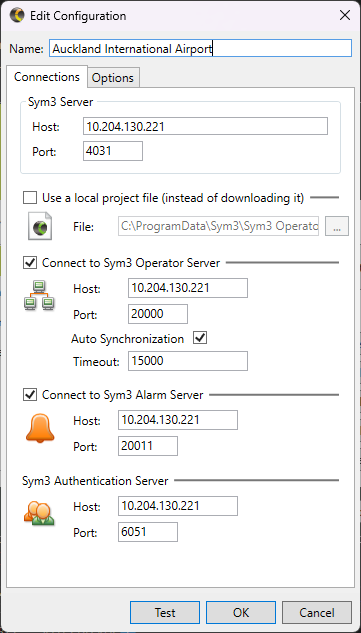
Connections tab
Sym3 Server
| Name | Description | Default |
|---|---|---|
| Host | Host name or IP address of the server. This is where Sym3 Web Service is installed. 💡Changing this value will automatically change the host of other services below except if there are using the same value. |
localhost |
| Port | The port used by Sym3 Web Service. It is not recommended to change this value. But if the default port of 4031 is hidden at the IT level, then you can set it to 0, this will also disable it from any request. 💡This is the case of Sym3 demo servers for example, if you are using a host = demo5.sym-3.com, set the port to 0. |
4031 |
Project File
| Name | Description | Default |
|---|---|---|
| Use a local project file | Instead of downloading the active project from the server (downloading through Sym3 Web Service), Sym3 Operator Client will load a local project. 💡This is used only for error investigation. This is not the recommended way. For example, if the local project is different from the server, Sym3 Operator Client won’t be able to connect to Sym3 Operator Server. |
Unchecked |
| File | This is the full path of the .s3o project file on the local machine. | C:\ProgramData\Sym3\Sym3 Operator\Project.s3o |
Sym3 Operator Server
| Name | Description | Default |
|---|---|---|
| Sym3 Operator Server | Tick to connect to a Sym3 Operator Server | On |
| Host | Name of the server host to act as Operator Server. | localhost |
| Port | Port to use for the Operator Server. | 20000 |
| Auto Synchronization | When ticked, enables Auto-synchronization | On |
| Timeout | It is a keep alive value in milliseconds. If the client doesn’t send any ‘keep alive’ during this period, Sym3 server will mark this client as ‘Disconnected’. Please note that the client will be disconnected only when a new connection arise on server side. | 15000 (15 seconds). |
PS: You can have multiple clients connected to the same port on a server but only one project (therefore one port) to connect to.
Sym3 Alarm/Log Server
| Name | Description | Default |
|---|---|---|
| Sym3 Alarm/Log Server | Tick to connect to a Sym3 Alarm Server | On |
| Host | Name of the server host to act as the Alarm Server. | localhost |
| Port | Port to use for the Alarm Server. | 20011 |
Sym3 Authentication Server
| Name | Description | Default |
|---|---|---|
| Host | Name of the server host to act as the Authentication Server. | localhost |
| Port | Port to use for the Authentication Server. | 6051 |
Options tab
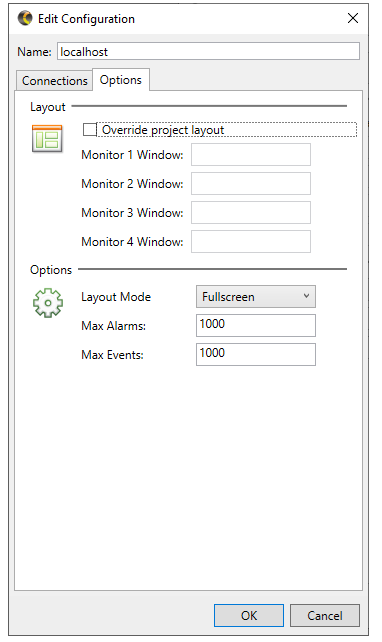
| Name | Description |
|---|---|
| Override project layout | Allows the user to override the layout defined in the Project file. |
| Monitor 1/2/3/4 Window | Define up to 4 monitor windows |
| Layout Mode | Select from one of:
|
| Max Alarms | Default = 1000 The maximum number of Alarms to store. Once this limit is reached, as a new alarm is triggered, the oldest Alarm is removed to make room for the new entry. |
| Max Events | Default = 1000 The maximum number of Events to store. Once this limit is reached, as a new Event is triggered, the oldest Event is removed to make room for the new entry. |
| Bypass SSL certificate checks | By default, Sym3 Operator Client will automatically ask to install the certificate on the machine for the current user when it connects to a server for the first time (see Start). If, for any reason, after installing the certificate, the client still can’t download the project file (it shows “Downloading, retry”) then you can tick this option to bypass the certificate check. The communication with the server will be still encrypted but not trusted which is ok, Sym3 services allow that. ⚠️ This option is not recommended by default, only if the client can’t download the project. |
Duplicate
To create a copy of the selected configuration.
Edit…
Opens the Edit configuration window (above) with the selected configuration. Press Ok to save changes, Cancel to discard.
Delete
Delete the selected Server connection. You will be asked to confirm the Delete action.
Note: Delete does not affect the Published Project, only removes the client configuration for it.
Test
This tool will check if the PC Client can connect to the remote services (Sym3 web service, Sym3 Operator service, Sym3 Alarm service and Sym3 Authentication service).
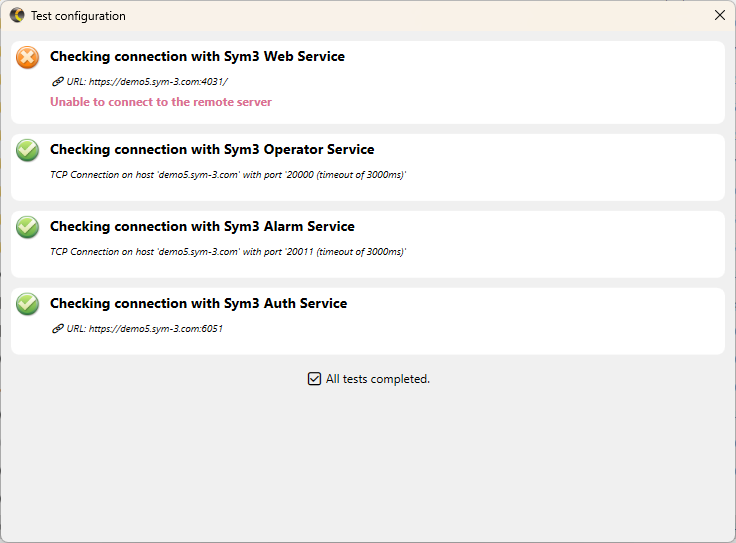
Start
It will execute the selected configuration the way it has been configured.
A standard scenario:
1️⃣ Connects to Sym3 Web Service,
2️⃣ Downloads the .s3o project file,
3️⃣ Loads the downloaded .s3o project file,
4️⃣ Displays the main window (how it has been configured in the options),
5️⃣ Connects to Sym3 Operator Server if ticked,
6️⃣ Connects to Sym3 Alarm Server if ticked.
💡 Note: the first time the PC client is connecting to Sym3 Web Service, the user will be asked to install the SSL certificate. It is a requirement. If the user does not accept it, the PC Client won’t be able to securely connect and communicate with Sym3 Web Server:
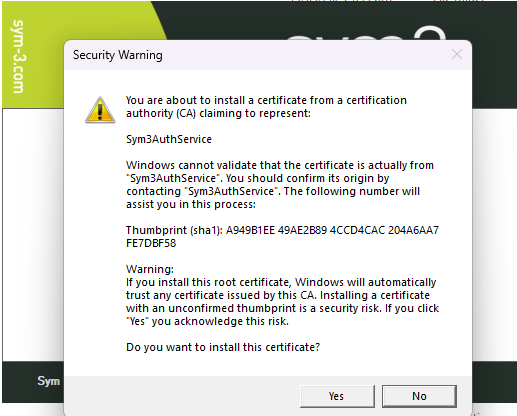
Settings…
When the Settings button is opened there are two setting options:
Popular
| Name | Description |
|---|---|
| Language | The default is English (US). The “Japanese” language is also supported. 💡Changing the language requires a restart of the application and you will be prompted to do this. 💡The selected language will not be applied to the project as it is independent. To learn more about languages in the project itself, please refer to Multi Language Support. |
| Disable the edit buttons | If checked, the ‘New’, ‘Edit’, ‘Duplicate’ or ‘Delete’ buttons will be disabled. It can be used to ‘block’ users to accidentally click on one of those buttons. |

Graphics
This screen allows the user to customize some 3D rendering settings. The settings that can be changed are:
| Name | Description |
|---|---|
| Frame rate | Number of frames per second. Reduce this if the machine response is ‘choppy’. |
| Shading | Set the shading to Smooth or Flat |
| Outline | Turn the outline On or Off. If On, a line is drawn on the edges of the 3d objects. |
| Disable 3D | Tick this box if you want to disable the 3D rendering. It is useful if you are running on a machine that doesn’t support OpenGL. |
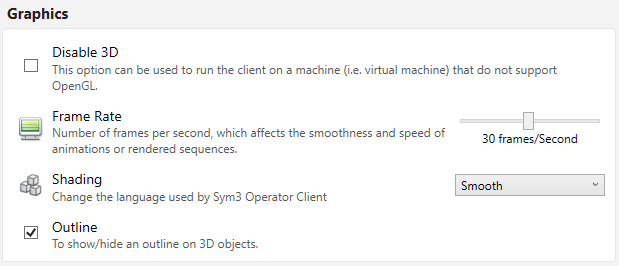
Advanced
Configurations are saved in the folder C:\ProgramData\Sym3\Sym3 Operator\ClientConfigurations with the extension .s3oc. By default, this extension is assigned to Sym3 Operator Client program.
💡 To start Sym3 Client directly with a configuration, it is recommended to create a shortcut of the .s3oc file of your choice for example on the Desktop. The end user can then double-click on it to start the client (the end user will not see the configuration selection window.)
💡 If you do not want the end user to change the configuration, you can limit the read/write rights directly on the .s3oc file.
